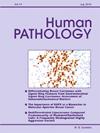Deep learning-based analysis of gross features for ovarian epithelial tumors classification: A tool to assist pathologists for frozen section sampling
IF 2.7
2区 医学
Q2 PATHOLOGY
引用次数: 0
Abstract
Computational pathology has primarily focused on analyzing tissue slides, neglecting the valuable information contained in gross images. To bridge this gap, we proposed a novel approach leveraging the Swin Transformer architecture to develop a Swin-Transformer based Gross Features Detective Network (SGFD-network), which assist pathologists for locating diseased area in ovarian epithelial tumors based on their gross features. Our model was trained on 4129 gross images and achieved high accuracy rates of 88.9 %, 86.4 %, and 93.0 % for benign, borderline, and carcinoma group, respectively, demonstrating strong agreement with pathologist evaluations. Notably, we trained a new classifier to distinguish between borderline tumors and those with microinvasion or microinvasive carcinoma, addressing a significant challenge in frozen section sampling. Our study was the first to propose a solution to this challenge, showcasing high accuracy rates of 85.0 % and 92.2 % for each group, respectively. To further elucidate the decision-making process, we employed Class Activation Mapping-grad to identify high-contribution zones and applied k-means clustering to summarize these features. The resulting clustered features can effectively complement existing knowledge of gross examination, improving the distinction between borderline tumors and those with microinvasion or microinvasive carcinoma. Our model identifies high-risk areas for microinvasion or microinvasive carcinoma, enabling pathologists to target sampling more effectively during frozen sections. Furthermore, SGFD-network requires only a single 4090 graphics card and completes a single interpretation task in 3 min. This study demonstrates the potential of deep learning-based analysis of gross features to aid in ovarian epithelial tumors sampling, especially in frozen section.
基于深度学习的卵巢上皮肿瘤大体特征分类分析:一种辅助病理学家进行冷冻切片取样的工具
计算病理学主要集中于分析组织切片,忽略了大体图像中包含的有价值的信息。为了弥补这一差距,我们提出了一种利用Swin Transformer架构开发基于Swin Transformer的总体特征检测网络(SGFD-network)的新方法,该网络可以帮助病理学家根据卵巢上皮肿瘤的总体特征定位病变区域。我们的模型在4129张粗略图像上进行了训练,在良性、交界性和癌组中分别达到了88.9%、86.4%和93.0%的高准确率,与病理学家的评估非常吻合。值得注意的是,我们训练了一个新的分类器来区分交界性肿瘤和微侵袭性或微侵袭性肿瘤,解决了冷冻切片取样的重大挑战。我们的研究首次提出了解决这一挑战的方法,显示出每组的准确率分别高达85.0%和92.2%。为了进一步阐明决策过程,我们使用Class Activation Mapping-grad来识别高贡献区域,并使用k-means聚类来总结这些特征。所得到的聚类特征可以有效地补充现有的大体检查知识,提高交界性肿瘤与微侵袭性或微侵袭性癌的区分。我们的模型确定了微侵袭或微浸润癌的高风险区域,使病理学家能够在冷冻切片时更有效地靶向取样。此外,sgfd网络只需要一个4090显卡,并在3分钟内完成一个解释任务。该研究表明,基于深度学习的总体特征分析有助于卵巢上皮肿瘤采样,特别是冷冻切片。
本文章由计算机程序翻译,如有差异,请以英文原文为准。
求助全文
约1分钟内获得全文
求助全文
来源期刊

Human pathology
医学-病理学
CiteScore
5.30
自引率
6.10%
发文量
206
审稿时长
21 days
期刊介绍:
Human Pathology is designed to bring information of clinicopathologic significance to human disease to the laboratory and clinical physician. It presents information drawn from morphologic and clinical laboratory studies with direct relevance to the understanding of human diseases. Papers published concern morphologic and clinicopathologic observations, reviews of diseases, analyses of problems in pathology, significant collections of case material and advances in concepts or techniques of value in the analysis and diagnosis of disease. Theoretical and experimental pathology and molecular biology pertinent to human disease are included. This critical journal is well illustrated with exceptional reproductions of photomicrographs and microscopic anatomy.
 求助内容:
求助内容: 应助结果提醒方式:
应助结果提醒方式:


